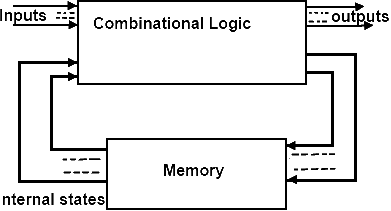Sequential Logic Circuits
In digital circuits, such as comparators, two 8-bit numbers may be considered to generate and output only when they are the same. Such circuits and those of adders, multipliers, can all be built from basic NAND and NOR gates, they are called combinational logic circuits.
Another requirement in electronics is to have circuit whose subsequent output depends on memory of the past 'sequence' of inputs and outputs. For example a circuit, which can sum up the number of 1's in a sequence or generate the outputs in the right order, is needed for a street crossing traffic light. Thus the moment all for red lights are operated, the circuit would have to remember, which road last had the green lights, so as to give other road the go next. The basic element in all sequential logic is a simple memory element known as flip-flops.
The microprocessor is the central processing unit (CPU) of a microcomputer. It is the heart of microcomputer. The intel corporation has also developed a large number of general purpose and special purpose peripheral devices. These devices are very valuable for the development of microprocessor based systems. The availability of a variety of support devices is also one of the causes of popularity of Intel 8085.
Sequential Circuits
A sequential logic circuit is defined as the one in which the present output is a function of the previous history or sequence of the inputs and also of the present input combination. Thus an important concept in the study of circuit. The internal state is the set of values of the outputs of the memory elements. A sequence of inputs takes the circuit through a sequence of internal states, each of which is characterized by a set of allowable successor states. The input combination determines which of the allowable successor states is the one to which the system goes.
Types of Sequential Circuits
There are two types of sequential circuits mentioned as
- Asynchronous (unclocked)
- Synchronous (Clocked)
Asynchronous circuits don not have any clock or timing circuit involved with them. In these circuits after completing one event, the event takes place. Such circuits will have a feedback path for finding the internal states i.e. the present outputs for generating successive outputs. Naturally a delay circuit or memory is required for this purpose. This feedback path thus consists of either a delay circuit or a flip-flop. The block diagram of an asynchronous circuit is shown in Figure 1.

The synchronous system always required 'clock signal' or the synchronizing pulses. The memory element get the input only at occurrence of these pulses. The pulses are mostly equally spaced but this is not essential. The duration of these pulses should be shorter than the time required for setting of the flip-flops and for propagation of signals around the feedback to the gates where the clock pulse is applied. Synchronous circuit is shown in figure 2.

